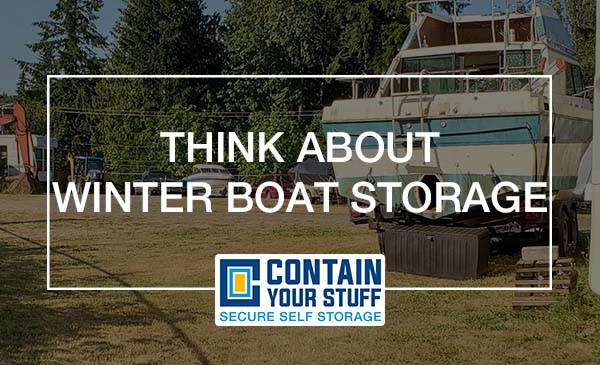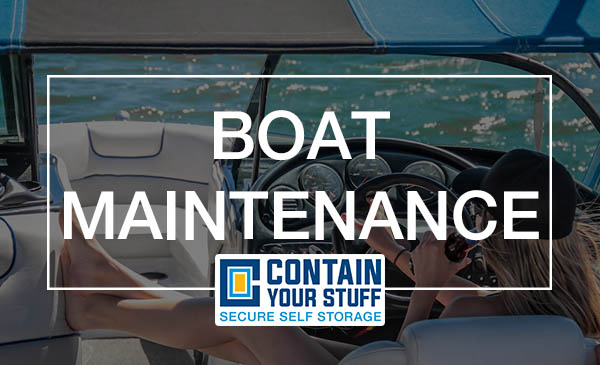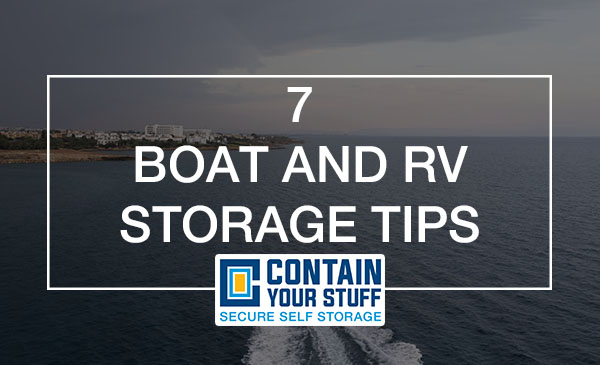
Storage Tips
August 25, 2022
How to Store Appliances
September 21, 2022How to Prep Your Boat For Winter Storage
Winter is a great time to get outside and enjoy the fresh air, but your boat will need some special attention before it can be put away for the season. Follow these tips below to ensure your boat stays in good shape while you hibernate until spring arrives!
Winterizing your boat
Winterization is the process of preparing your boat for storage during the winter months. There are several things you can do to winterize your boat and keep it in good shape.
- Put antifreeze in the engine, cooling system, transmission, and fuel tank. If using an alcohol-based antifreeze product like SeaKlear or ProMariner’s Ice Maker Plus Marine Antifreeze/Coolant Concentrate, add one ounce per gallon of water (1:50 ratio) to prevent freezing damage due to expanding ice crystals that build up when water freezes inside an engine block’s cooling passages and hoses; if using a glycol-based product such as our ProMariner Premium Plus Marine Antifreeze & Coolant Concentrate with built-in corrosion inhibitors (1:10 ratio), use one teaspoon per gallon of water.* Add corrosion inhibitor to the cooling system once it has been filled with fresh water from your winterizing procedure.* Drain all excess fluid from any batteries on board before storing them for long periods of time.* Keep all equipment out of direct sunlight with adequate shade protection such as tarps or sun shades over decks
Stabilize the fuel inside your boat’s tank.
The best way to make sure your fuel doesn’t turn into a thick, gooey mess is with a fuel stabilizer. Adding one of these products into your tank will help prevent water from seeping in and turning the gas into an unusable substance.
Once you’ve added the stabilizer, run your engine until it stops. If you know how long this takes on average (say 10 minutes), you can run it for that amount of time and then let it sit for a few days before trying again. This will ensure that all the fuel has been treated properly and won’t cause any problems when you start up again later on down the road. The next step is running it again after letting it sit overnight or more than 48 hours—just enough time, so there’s no chance of freezing temperatures freezing up inside your boat’s fuel lines during storage!
Flush the engine after adding the antifreeze/corrosion inhibitor.
You’ll want to have the engine fully warmed up, so this is a good time to do that.
Place a garden hose into the boat’s water intake and open the valve, then turn on the engine. Let it run for about five minutes while you spray down every inch of metal with water.
Turn off the engine and let it cool down before shutting it off completely. Then use a high-pressure washer on all surfaces to clean away any residue from antifreeze/corrosion inhibitor or other chemicals you may have used in your cleaning process.
Coat metal parts with lubricant.
If you have a boat with metal parts, such as the propeller, rudder and engine, coat them with lubricant. This will keep them from rusting over winter. It’s also a good idea to use silicone-based lubricant instead of petroleum-based products, which can stain painted surfaces.
Change oil and filters. This will help reduce the risk of corrosion inside the engine by removing contaminants that could cause damage while it sits idle all winter long.
You’ll want to change the engine oil and filter, transmission fluid and filter (if equipped), and coolant. The reasoning behind these changes is simple: they help reduce the risk of corrosion inside an idle engine by removing contaminants that could cause damage while it sits idle all winter long. Additionally, remove your battery and store it in a dry location away from extreme heat or cold. It’s a good idea to disconnect any electronic accessories that are not needed for winter storage, as well as protect your boat from rodents and other pests.
Protect leather, vinyl and metal surfaces with a UV protectant or vinyl sealant before storing.
Protect leather, vinyl and metal surfaces with a UV protectant or vinyl sealant before storing. Leather, no matter how well maintained, can become brittle and crack when exposed to prolonged exposure to sunlight. The same is true of vinyl cushions. Metal components such as chrome trim are particularly susceptible to oxidation during winter storage.
UV protectants prevent fading caused by ultraviolet rays, while also repelling water stains caused by rain or other moisture that penetrates the surface during storage. Vinyl sealants help combat scratches on plastic surfaces caused by insects like ants who may find their way into your boat during the off-season months because they’re looking for food sources that were left behind when you stored your boat away from home in anticipation of colder weather coming soon after Labor Day weekend signals summer’s end!
Don’t forget about electronics, wiring and accessories. All metal components can be corroded or damaged if they’re left exposed during winter storage, so don’t forget about the little things like hooks, lures, rods, reels and other accessories (especially soft plastics) that can be damaged by UV rays or rodents when you store your boat for the winter months.
If you’re going to store your boat for the winter, you’ll want to make sure that all the electronics and wiring are protected from water damage. Don’t forget about the little things like hooks, lures, rods and reels that can be damaged by UV rays or rodents when you store your boat for the winter months.
Power down accessories and chargers; disconnect batteries if applicable. Prevents deep-cycle battery sulfation, which is what occurs when a battery is charged and discharged repeatedly over time, and leads to shorter battery life overall.
- Power down accessories and chargers. The goal here is to prevent deep-cycle battery sulfation, which is what occurs when a battery is charged and discharged repeatedly over time and leads to shorter battery life overall.
- Disconnect batteries if applicable. This is especially important if you have an onboard charger that’s always on and connected to your batteries while you’re not using them (like when they’re stored in your boat). If you don’t disconnect the charger, it may continue to charge the batteries even after they’ve been disconnected from power sources—and that can lead to damage!
It’s important to remember that the winterizing process doesn’t just apply to boats. If you have access to a garage or covered carport, then you can do all of these steps for your car as well. Get secure boat storage today!




